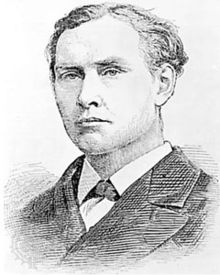Kategóriák




További információért, kérjük, hívja a +(36 30) 1999-441 telefonszámot.
Edward Whymper : Warwick kastély metszet
Termék kód: [0L861/19]
A kép mérete keret nélkül: 16 x 24 cm
Edward Whymper

Edward Whymper, engraving, 1881
|
|
| Personal information | |
|---|---|
| Nationality | English |
| Born | 27 April 1840 London, England |
| Died | 16 September 1911 (aged 71) Chamonix, France |
| Occupation | Mountaineer, illustrator, author |
| Climbing career | |
| Known for | Matterhorn first ascent |
| First ascents |
|
Edward Whymper (27 April 1840 – 16 September 1911) was an English mountaineer, explorer, illustrator, and author best known for the first ascent of the Matterhorn in 1865. Four members of his climbing party were killed during the descent.[1][2] Whymper also made important first ascents on the Mont Blanc massif and in the Pennine Alps, South America, and the Canadian Rockies. His exploration of Greenland contributed an important advance to Arctic exploration. Whymper wrote several books on mountaineering, including Scrambles Amongst the Alps.
Contents
[hide]- 1Early life
- 2The Matterhorn
- 3Exploration in Greenland
- 4South American exploration
- 5Canadian Rockies
- 6Illustrator
- 7Final years
- 8Works
- 9References
- 10External links
Early life[edit]
Edward Whymper was born in London, England, on 27 April 1840 to the artist and wood engraver Josiah Wood Whymper and Elizabeth Claridge. He was the second of eleven children, his older brother being the artist and explorer Frederick Whymper. He was trained to be a wood-engraver at an early age. In 1860, he made extensive forays into the central and western Alps to produce a series of commissioned alpine scenery drawings. Among the objects of this tour was the illustration of an unsuccessful attempt made by Professor Bonney's party to ascend Mont Pelvoux, at that time believed to be the highest peak of the Dauphiné Alps.
In 1861, Whymper successfully completed the ascent of Mont Pelvoux, the first of a series of expeditions that threw much light on the topography of an area at that time very imperfectly mapped. From the summit of Mont Pelvoux, Whymper discovered that it was overtopped by a neighbouring peak, subsequently named the Barre des Écrins, which, before the annexation of Savoy added Mont Blanc to the possessions of France, was the highest point in the French Alps. Whymper climbed the Barre des Écrins in 1864 with Horace Walker, A. W. Moore and guides Christian Almer senior and junior.
The years 1861 to 1865 were filled with a number of new expeditions in the Mont Blanc massif and the Pennine Alps, among them the first ascents of the Aiguille d'Argentière and Mont Dolent in 1864, and the Aiguille Verte, the Grand Cornier and Pointe Whymper on the Grandes Jorasses in 1865. That year he also made the first crossing of the Moming Pass. According to his own words, his only failure was on the west ridge of the Dent d'Hérens in 1863.[3] As a result of his Alpine experience, he designed a tent that came to be known as the "Whymper tent" and tents based on his design were still being manufactured 100 years later,
Forrás: www.wikipedia.org






 e-mail ajánlás
e-mail ajánlás